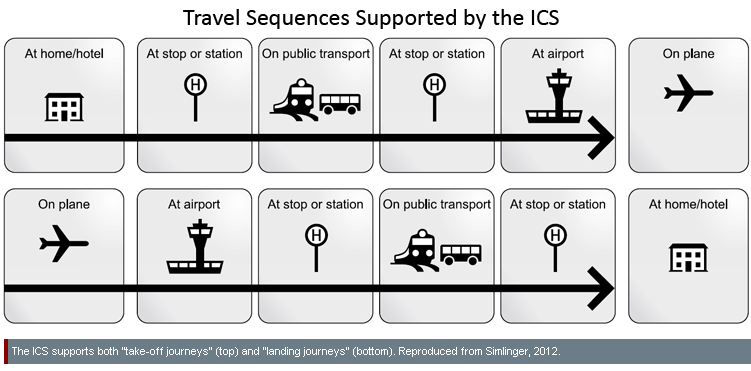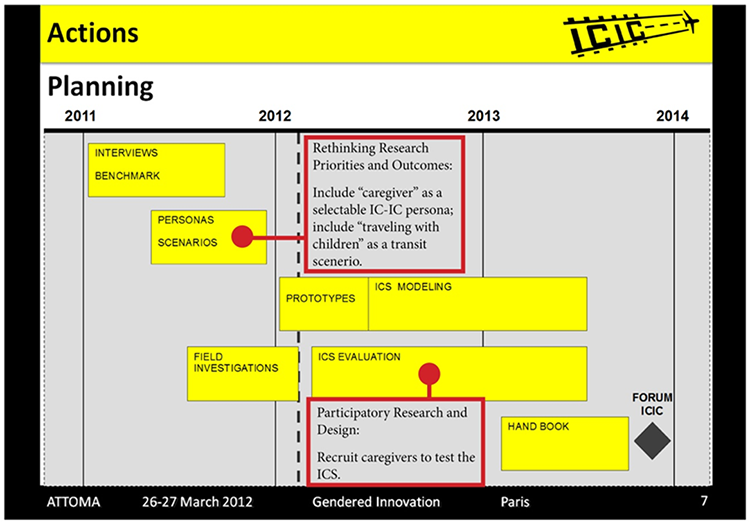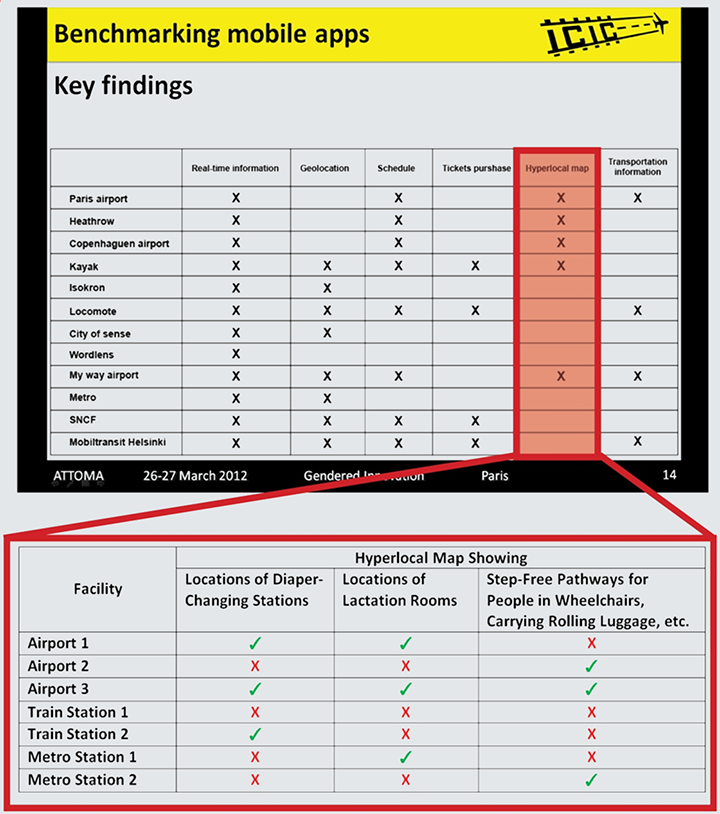Sex & Gender Analysis
- Methods
- Rethinking Research Priorities and Outcomes
- Rethinking Concepts and Theories
- Formulating Research Questions
- Analyzing Sex
- Analyzing Gender
- Analyzing how Sex and Gender Interact
- Analyzing Factors Intersecting with Sex and Gender
- Engineering Innovation Processes
- Designing Health & Biomedical Research
- Participatory Research and Design
- Rethinking Standards and Reference Models
- Rethinking Language and Visual Representations
- Terms
- Checklists
Case Studies

Information for Air Travelers: Participatory Research and Design
The Gendered Innovations project was asked by the European Commission to analyze several of its Framework Programme 7 (FP7) projects. This case study examines the “Interconnectivity through Infoconnectivity” (IC-IC) project. We summarize the IC-IC project and identify points of potential "value added" through the future application of gendered innovations methods.
Interconnectivity through Infoconnectivity
Air travelers may have unmet needs for information when navigating unfamiliar airports. These needs arise from lack of standardized timetables and inconsistencies in ticket category types, pictograms, names for destinations, etc. (Bonsall et al., 2011).
IC-IC aims to produce an ICS (InfoConnectivity System) to optimize air travelers’ access to information. The ICS is to be piloted at four major international airports: Amsterdam (Schipol), Frankfurt, Paris (Charles de Gaulle), and Vienna. IC-IC seeks to make travel faster and more efficient, primarily by easing transfers between public transport (road, rail, etc.) and air travel. IC-IC also seeks to improve accessibility for the elderly and for travelers speaking different languages (CORDIS, 2012).
Potential Value Added to Future Research through the Application of Gendered Innovations Methods:
- 1. Researching the needs of caregivers and available airport infrastructure.
- 2. Providing information to support traveling caregivers and their dependents.
Background: The European Union Framework Programme 7 (FP7) Interconnectivity through Infoconnectivity (IC-IC) Project
Assessing User Needs
Potential Value Added to Future Research through the Application of Gendered Innovations Methods
Value Added 1: Researching the Needs of Caregivers and Available Airport Infrastructure
Method: Analyzing Intersecting Factors
Value Added 2: Providing Information to Support Traveling Caregivers and their Dependents
Method: Rethinking Research Priorities and Outcomes
Method: Participatory Research and Design
Conclusions
Next Steps
The Challenge
International travelers face a variety of difficulties. Even well-traveled individuals can be challenged when transferring from one transport system to another in foreign airports. Information related challenges in airports and other transit facilities can include:
- ● Inconsistent or absent signage, maps, transit information, etc. (Boëzennec, 2012).
● Unavailability of information in a traveler’s native language (Jiajun, 2009).
● Lack of personalized and contextualized information (Rehrl et al., 2007).
Background: The European Union Framework Programme 7 (FP7) Interconnectivity through Infoconnectivity (IC-IC) Project
The IC-IC project aims to develop an ICS (InfoConnectivity System) for long-distance travelers at four major European airports: Amsterdam (Schipol), Frankfurt, Paris (Charles de Gaulle), and Vienna. The goal is to offer information to passengers that enhances the speed and ease of transfer between long- and short-distance transportation networks (aeronautics, road, and rail). (CORDIS, 2012)—see image below.
IC-IC intends to provide information to travelers in waiting situations, including standing in security screening lines, waiting in airplanes and lounges, etc. (CORDIS, 2012). ICS is to deliver information in two general categories:
- 1. Transit, including check-in, ticketing, schedules, connecting ground transportation, immigration and customs requirements, security, etc.
- 2. Facilities and Services, including both in-airport services (lost and found, security, shopping, restaurants, currency exchange, etc.) and outside facilities and services (hotels, healthcare centers, etc.) with maps, directions, opening hours, etc. (International Institute for Information Design, 2012).
Information is to be developed in English. Machine translation software is to allow information to be displayed in English or one of thirteen additional languages, depending on the users’ profile. More traditional forms of information dissemination, such as booklets, pamphlets, in-flight entertainment systems, or posters, could also be used.
Assessing User Needs
ICS’ success requires understanding the needs of business and tourist travelers from different countries and backgrounds. The project employs a variety of methodologies:
- 1. Interviews with potential future users. Researchers collected information from 4,531 travelers from Poland, Russia, and Spain (International Institute for Information Design, 2011b). Online surveys explored situations that travelers may face while undertaking a journey that involves flying, to determine where information needs exist. These situations were specifically related to information needs while:
● traveling to the airport using public transportation
● at the airport
● or approaching the airport as a passenger on a plane (Private Communication, 2012). - 2. Collaboration with institutional stakeholders. As of 2011, this includes four airports, four airlines, and nine surface transit operators. IC-IC is also working with the: aircraft manufacturer Airbus, European Disability Forum, Airport Regions Conference, Airports Council International Europe, European Travel Commission and International Association of Public Transport (IC-IC, 2011a).
- 3. Studies of existing information systems. Researchers have investigated airport ticketing systems, self check-in stations, and other facilities that travelers currently use. This allows IC-IC investigators to determine what useful information is “missing” and how IC-IC might fill these gaps.
- 4. Collaboration with experts. A scientific advisory board was constituted that included experts from India, Japan, Taiwan, the U.S., and a number of European countries.
- 5. The “age simulator.” Test personnel used an age simulation suit to study the needs of elderly travelers (IC-IC, 2011b).
Data from these sources was combined to build personas representing the most representative passenger target groups and typical journeys representing their movements. Personas included women and men business and touristic travelers. The objective is to identify the current level and quality of information provided to travelers, and to identify significant shortfalls. From these diverse sources, as well as fact finding activities carried out at airports and connecting ground transportation, model ICS applications will be developed and implemented to serve in real life situations (Private Communication, 2012).
Potential Value Added to Future Research through the Application of Gendered Innovations Methods
Value Added 1: Researching the Needs of Caregivers and Available Airport Infrastructure
People traveling by air for business or professional purposes may travel with children (Urry, 2007). Several effects of long-distance travel on family life have been described (Espino et al., 2002). Major institutions, such as Stanford University, provide junior faculty with grants applicable to “reasonable dependent care expenses” if dependents must accompany them on trips. Such funding may also be used to support “dependent care at a conference or research site” (Stanford University, 2012). For these reasons, the ICS will be enhanced if it provides information concerning care facilities. In airports, this may include lactation or quiet bottle-feeding rooms, changing rooms, play areas, etc. In arrival cities, this might include information about parks and playgrounds, child activity centers, childcare services and emergency pediatric health care.
Method: Analyzing Intersecting Factors
Researchers can apply this method by:
1. Studying the demographics of travelers who fly with dependents (children, elderly persons, etc.). The proportion of travelers who travel as caregivers should be disaggregated by variables such as:
● Sex
● Age
● Relationship to dependent (mother/father, other relative, etc.)
● Main trip purpose (business or leisure)
● Travel route (origin and destination)
● Native language
● Type of employment (field of work, seniority, private-sector/public-sector/academic), etc.
● Level of employer’s support (if any) for traveling with dependents (Private Communication, 2012).Such information could be obtained through surveys, which would be designed to capture the behaviours of diverse groups of travelers. For example, academic workers might be more likely to travel with children than private-sector workers, and a survey which captured only private-sector workers would then be non-representative.
2. Compiling information on the availability of childcare facilities (lactation rooms, changing rooms, etc.) in various airports, possibly including air traveler’s evaluations of the quality of these facilities. Currently, the IC-IC project has benchmarked the quality of information available to travelers at several airports and other transit facilities (such as train and metro stations). This benchmarking could be expanded to include variables related to childcare—see image below.
In the short term, these actions would assist travelers with children in identifying the resources available to them. In the long term, consistent and standardized data about such facilities could encourage improvement in the availability of such resources.
Value Added 2: Providing Information to Support Traveling Caregivers and their Dependents
Once information is gathered, it may be distributed by:
- 1. Providing airport maps (“hyperlocal maps”) showing the locations of care facilities.
- 2. Delivering customized information to traveling caregivers; that is, including “caregivers” as a categorical profile in considering different travel scenarios. An ICS user could select “traveling with children” so as to receive relevant, customized information—just as this user might select a specific language, traveling with or without checked baggage, etc.
Method: Rethinking Research Priorities and Outcomes
ICS designers may wish to show routes within airports and ground transportation that provide step-free access to planes, trains, subways, and buses. This accommodates strollers, heavy luggage, wheelchairs, and similar devices, helping the ICS to achieve the stated goal of providing “intertwined information, ‘designed for all’” (Simlinger, 2011). Prioritizing research on traveling caregivers could be incorporated into IC-IC Planning Actions—see image below.
Method: Participatory Research and Design
As of 2011, IC-IC researchers have interviewed “more than 4500 persons in Poland, Russia, and Spain” to understand the travel needs of potential ICS users (IC-IC, 2011b). Including sufficient numbers of caregivers during ICS evaluation could increase the ICS user base, and could be incorporated into ICS Planning Actions—see image below.

Conclusions
Design research must be conceived to ensure that all users’ needs are adequately addressed. IC-IC analyzed typical travelers and modeled the special needs of the elderly. Various strategies beyond those contained in the original IC-IC project description can be used to add value through the application of gendered innovations methods. Analyzing the demographics of travelers who fly with dependents and compiling information on the availability of childcare facilities in various airports might further enhance ICS.
Next Steps
Transportation researchers may work to:
- ● incorporate the needs of caregivers (locations for parents to prepare food, and lactation rooms; and childcare services and
emergency pediatric health care in arrival city) as requirements in the ICS
● deliver customized information to traveling caregivers
● allow users to select their “needs”
● include “caring work” as a subset of health and well being
Works Cited
Boëzennec, K. (2012). “Gendered Innovations in the IC-IC Project.” Gendered Innovations in Science, Medicine, and Engineering Project March Workshop, March 26-March 27, Ministry for Higher Education and Research, Paris.
Bonsall, P., Abrantes, P., Bak, M., Bielefeldt, C., Borkowski, P., Maffii, S., Mandel, B., Matthews, B., Shires, J., Pawlowska, B., Schnell, O., & de Stasio, C. (2011). Interconnection between Short- and Long-Distance Transport Networks (INTERCONNECT)—An Analysis of Potential Solutions for Improving Interconnectivity of Passenger Networks. Brussels: European Commission.
Cai, K., & Zhang, C. (1996). “Towards a Research on Information Pollution.” Proceedings of the Institute of Electrical and Electronics Engineers (IEEE) International Conference on Systems, Man, and Cybernetics, October 14-October 17, Beijing.
Cleary, F., Fiedler, M., Ridel, L., & Chiat-Toker, A. (2009). “PERIMETER: Privacy-Preserving Contract-less, User Centric, Seamless Roaming for Always Best Connected Future Internet.” Proceedings of the 22nd Wireless World Research Forum (WWRF), May 5th-7th, Paris.
Community Research and Development Information Service (CORDIS). (2012). Project: Enhancing Interconnectivity through Infoconnectivity.
Egger, S. (2011). Definition of the Information-Connectivity System (ICS). Stuttgart: International Institute for Information Design (IIID).
Espino, C., Sundstrom, S., Frick, H., Jacobs, M., & Peters, M. (2002). International Business Travel: Impact on Families and Travelers. Occupational and Environmental Medicine, 59 (5), 309-322.
Europa Press releases RAPID. (2011). Digital Agenda: New price caps for mobile data roaming expected to save families over €200 each year and business travellers over €100 [Press release].
Flughafen Wien. (2012). Vienaairport—Services—Open for New Horizons.
Interconnectivity through Infoconnectivity (IC-IC). (2011a). IC-IC Stakeholders.
Interconnectivity through Infoconnectivity (ICIC). (2011b). Newsletters Summary.
International Institute for Information Design (IIID). (2012). IC-IC.
Jiajun, X. (2009). “Beijing Guidance Information System: Major Problems and Solutions.” Proceedings of the Institute of Electrical and Electronics Engineers (IEEE) International Conference on Management and Service Science, October 20-October 22, Wuhan, China.
Private Communication. (2012). Communication with IC-IC design team, August 21st.
Rehrl, K., Bruntsch, S., & Mentz, H. (2007). Assisting Multimodal Travelers: Design and Prototypical Implementation of a Personal Travel Companion. Institute of Electrical and Electronics Engineers Transactions on Intelligent Transportation Systems, 8 (1), 31-42.
Shortall, T. (2010). A Structural Solution to Roaming in Europe. Florence: Robert Schuman Centre for Advanced Studies (RSCAS).
Simlinger, P. (2012). “Information for Ground & Air Travelers: Participatory Research and Design.” Presentation at the Gendered Innovations in Science, Medicine, and Engineering Experts’ Workshop, September 20th—21st, Brussels.
Simlinger, P. (2011). Project Description: Enhancing Interconnectivity of Short and Long Distance Transport Networks through Passenger-Focused Interlinked Information-Connectivity. [Link]
Stanford University. (2012). Junior Faculty Dependent Care Travel Grant Program.
Urry, J. (2007). Mobilities. Cambridge: Polity Press.
WESTbahn. (2012). Surf on Board.
The Gendered Innovations project was asked by the European Commission to analyze several of its Framework Programme 7 (FP7) projects. This case study examines the "Interconnectivity through Infoconnectivity" (IC-IC) project. We summarize the IC-IC project and identify points of potential "value added" through the future application of gendered innovations methods.
IC-IC aims to develop information connectivity for travelers. The goal is help passengers maneuver seamlessly from their homes to the airport, through public transportation systems, and on to their hotels.

To this end, IC-IC has developed mobile information systems to assist with check-in, ticketing, schedules, connecting ground transportation, immigration and customs requirements, security, and services (lost and found, shops, restaurants, currency exchange, etc.).
Potential Value Added to Future Research through the Future Application of Gendered Innovations Methods:
People traveling for business increasingly travel with children. Major institutions, such as Stanford University, provide junior faculty with travel grants for dependents.
IC-IC's information services (and potential customer base) may be enhanced by adding an additional category: information concerning care facilities. In airports, this may include lactation or quiet bottle-feeding rooms, changing rooms, play areas, etc. In arrival cities, this might include information about parks and playgrounds, child activity centers, childcare services, and emergency pediatric health care.







